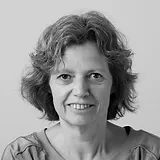
Anke van den Berg
prof. dr.
I work as a clinical molecular biologist in the department of Pathology. In this function I supervise and implement advanced molecular diagnostic techniques. Within my research line, I focus on the molecular pathogenesis of B-cell Hodgkin and non-Hodgkin lymphoma. The specific fields of interest are genomic aberrations, genetic susceptibility, and the role of small and long noncoding RNAs. I have several international collaborations and am PI and co-PI in various projects.
Splenic marginal zone lymphomas presenting with splenomegaly and typical immunophenotype are characterized by allelic loss in 7q31-32
Published in: Modern Pathology
Access to document
10.1097/01.MP.0000095895.19756.77
Ronald Boonstra, Annigje Bosga - Bouwer, G.W. van Imhoff, V. Krause, M Palmer, R.W. Coupland, L. Dabbagh, Eva van den Berg, Anke van den Berg, Sibrand Poppema
Production of hemopexin by TNF-alpha stimulated human mesangial cells
Published in: Kidney International
Access to document
10.1046/j.1523-1755.2003.00907.x
Background. Plasma hemopexin has been shown to induce proteinuria after intrarenal infusion in rats, as well as glomerular alterations identical to those seen in corticosteroid-responsive nephrotic syndrome (CRNS). The question emerged whether also renal cells are potentially able to release hemopexin. Methods. Normal human mesangial cells (HMC) were incubated overnight in serum-free medium with or without tumor necrosis factor-alpha (TNF-alpha) (10 ng/mL). Parallel cultures were supplemented with prednisolone (10(-3) mol/L). Concentrated supernatants were analyzed by Western blotting, using antihemopexin immunoglobulin G (IgG). Antitransferrin IgG served as control antibody....
Jola Jovita Kapojos, Anke van den Berg, Harry van Goor, Maroeska W. M. te Loo, Klaas Poelstra, Theo Borghuis, W.W Bakker
Clonal relation in a case of CLL, ALCL, and Hodgkin composite lymphoma
Large cell lymphomas and Hodgkin disease may develop during the course of chronic lymphocytic leukemia (CLL). In some cases the transformed cells are Epstein-Barr virus (EBV)-positive and not clonally related to the CLL cells. In other cases the transformed cells have the same clonal rearrangements as the CLL cells. Here we describe a composite lymphoma in a patient with CLL that exhibits a combination of CLL/small lymphocyte lymphoma, large cell lymphoma with anaplastic morphology, and Hodgkin lymphoma (HL). Although the large cell lymphoma cells are CD45R0 and TIA-1-positive,...
Anke van den Berg, Ewerton Maggio, R Rust, K Kooistra, A Diepstra, S Poppema
Common and differential chemokine expression patterns in RS cells of NLP, EBV positive and negative classical Hodgkin lymphomas
Published in: International Journal of Cancer
Access to document
10.1002/ijc.10399
Hodgkin lymphoma (HL) is characterized by a minority of neoplastic cells, the so-called Reed-Sternberg (RS) cells and a vast majority of reactive cells. RS cells produce chemokines that can attract subsets of peripheral blood cells into HL tissues. To gain insight in the chemokines involved in HL, 16 chemokines were selected based on their ability to recruit different subsets of cells. Five HL, 5 non-HL-derived cell lines, 22 HL, 5 non-HL and 3 control tissues were analyzed by reverse transcriptase-polymerase chain reaction (RT-PCR). Products for 13 of these...
Germline FAS gene mutation in a case of ALPS and NLP Hodgkin lymphoma
FAS germline mutations have been associated with the development of autoimmune lymphoproliferative syndrome (ALPS). Occurrence of Hodgkin lymphoma (HL) has been reported in 2 families with ALPS. In both families an uncle of the index patient developed HL. A 15-year-old boy with autoommune thrombopenia, lymphadenopathy, and splenomegaly for 6 years was studied. In an axillary lymph node biopsy nodular lymphocyte predominant (NLP) HL was diagnosed; In the areas between the nodules a proliferation of double-negative blastic T-cells were present, suggestive of ALPS. Analysis for the presence of a...
Anke van den Berg, Ewerton Maggio, A Diepstra, Doetje de Jong, J van Krieken, S Poppema
